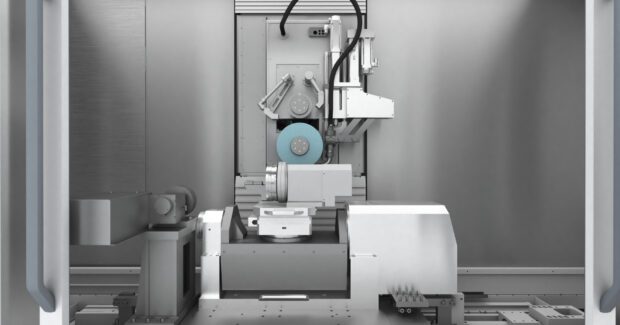Increase Productivity with a Five-in-One Machine
The Elb-Schliff millGrind BL10 from Precision Surfacing Solutions (PSS): grinding, drilling, and milling in one clamping; deep grinding and, with an optional laser head, deposition welding in the other. A complete machining solution for aerospace manufacturers.
Posted: January 6, 2020
The Elb-Schliff millGrind BL10 from Precision Surfacing Solutions (PSS; Mount Prospect, IL) saves on capital costs and changeover and retrofit times by performing five operations: grinding, drilling and milling in one clamping; deep grinding and, with an optional laser head, deposition welding in the other.
With 2- or 3-axis indexing head. High axis speeds reduce nonproductive times to a minimum. The powerful spindle performs milling and drilling operations up to 10,000 rpm.
The overhead dresser was specially developed for highly productive deep grinding.
An additional dressing device on the work table creates flexible grinding wheel profiles, intended mainly for interpolating the dressing with diamond section rollers.
Modularly expandable tool changer magazine. The tool changer enables the simultaneous change of dressing roller and grinding wheel, reducing set-up time. The magazine holds up to 60 tools, including grinding wheels, dressing rolls, measuring probes, and milling and drilling tools.
In-process measurement included. Integrated measuring probe operated via a flexible software package can measure finished parts and clamped unmachined parts to automatically compensate for positional and clamping errors.
Operating errors almost impossible. Clamping technology is particularly important when automating complete machining of turbine blades. Exact positioning isn’t possible because of large film deviations (around ±0.1 mm) at the clamping points. Before machining, it’s therefore expedient to measure component position using a coordinate measuring machine (CMM). Measurements are converted into compensation data and assigned to the respective processing machine by the cell control on a component-specific basis. The 6-axis design of the machines thus makes it possible to compensate for most clamping errors.
“Within the cell, the components, devices, and tools can be traced clearly via RFID chips or data matrix codes,” says CEO Matthias Mantel. “Operating errors are practically impossible.”
Optional additive laser deposition welding. A laser head is easily integrated into the machine via a tool change for laser hardening, marking, and additive material welding functions. High-precision laser deposition welding is particularly suitable for aircraft components. Grinding is particularly economical when machining difficult materials such as nickel and superalloys in aircraft construction. Deposition welding can also be used for blade repair. It can then be ground to size in a second machining step without re-clamping.
Precision Surfacing Solutions (PSS), 501 W. Algonquin Road, Mt. Prospect, IL 60056, 877-352-8637, [email protected], www.precision-surface.com.















